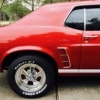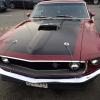-
Content Count
529 -
Joined
-
Last visited
-
Days Won
6
Reputation Activity
-
 SA69mach got a reaction from JayEstes in factory a/c w/ ps pulley photos wanted
SA69mach got a reaction from JayEstes in factory a/c w/ ps pulley photos wanted
Also,
Power steering pulley is driven by the 'center belt' on the 3 groove crank pulley. It drives the fan/waterpump, AND over to run the power steering pump.
If you need brackets, pulleys or whatever for your 69, give Chockostang a call. Very nice man, and he knows exactly what engine needs what. He has helped me in a number of builds, and has helped many others. He has spares for most things, brakes, power steering, pumps, all that.
Worth a call if you are hunting 69 brackets. They can be a bit tricky to find. More to the point, it can be tricky to know what you NEED. There were a lot of changes to the engine and bracketry and water pumps, timing covers, and radiators in 1970,
You may even have a 'mix and match'. I did once, on a 70 coupe. It happens.
-
 SA69mach got a reaction from JayEstes in 69 Tire Rub ?
SA69mach got a reaction from JayEstes in 69 Tire Rub ?
A reliable tire choice for the 69 and 70 Mustangs in the 15 inch range is
front- 225/60/15 on a 15x7 (4.25" BS)
rear 255/60/15 on a 15x8 (4"BS)
Plenty of room at the rear for bigger. I run 275/60/15 rears on my 70 with no rub. (225/60/15 front) Seems that the 235 tire is sometimes a tiny bit too wide for 'some ' 69's but it depends on a lot of factors like manufacturing tolerances, lowering mods, collision repairs etc. Fender rolling cures it for most, but not all.
-
 SA69mach got a reaction from JayEstes in Help on getting an electronic tester
SA69mach got a reaction from JayEstes in Help on getting an electronic tester
As a novice I have managed to fix, or diagnose most of the electrical problems with my first Mustang, (a 70 coupe) and since then my second (a 69 Mach 1), using just a few tools.
The multimeter is the best tool, and as mentioned, get one with automatic shut-off, and audible continuity setting. They are accurate, robust, and can help in many different ways.
The multimeter is perfect for wiring for lights, horns, indicators, anything that is powered, and has a switch to provide the power. You can use it to test your battery, and your regulator.
A quick and useful tool is the simple test light, which is like a sharp screwdriver with a ground wire hanging out of the handle. Cheap, and when you clip the ground wire to a ground, (clean chassis metal, or negative battery terminal) you can easily test your fuses (both ends), and any wire with 12 volt power.
Many times you will need a way to put power into a test item, like a gauge, or a motor for a wiper, anything you have off the car. For this you will have choice of a purpose built power supply (usually variable voltage) or simply a good car battery with some big alligator clips on the terminals and small ones on the working ends. You need to be careful with these ends. Contacting them together will cause sparking and may damage your item with spikes and shorts. Rubber coated or shrouded clips will help. This will help with testing bulbs, especially the small instrument cluster bulbs and bulb holders, which always seem to be sketchy. I went through about twenty holders and new bulbs to get solid, working sets in both Mustangs. The 70 has the printed circuit board to power the instrument lights and gauges, for your information. You also have the IVR - Instrument Voltage Regulator or also called CVR -Constant Voltage Regulator. This unit breaks down the 12 volt feed to a 5 volt feed to power the gauges. Remember that if working on gauges - don't use 12 volts direct.
For working on gauges and sending units, the Mustangs have a specific resistance range for both. Ford use gauges and senders that show "full" at 10 ohms, and "empty" at 78 ohms. Chevrolet use zero to 90 ohms, for reference. Your temp, fuel and oil pressure gauges are all pretty much identical inside, and the senders are screwed in to the block, or in the gas tank, and are designed to vary their resistance according to changing temps. levels and pressures. They can be tricky to understand at first, but once you realize how they work with the gauges, it starts to get easier, to diagnose and isolate the problem.
I made a cheap box with a variable ohms output, and two wires to 'simulate' the ohms output to help with my gauges on both cars. Worked great and saved me time and frustration.
Not knowing what issues you are having, that is my list of helpful tools. Whatever is wrong, it has probably been had before by someone on here, and you will likely find a solution. Glad you are getting hands-on....post your questions when ready.
-
 SA69mach got a reaction from JayEstes in Fuel gauge won't go past 3/4
SA69mach got a reaction from JayEstes in Fuel gauge won't go past 3/4
Isolate the problem.
My money is on the old sender, but it could be the gauge.
First test is to remove the sender wire from the fuel sender, and with the ignition in the OFF position, ground the wire to the frame/chassis. Then switch ignition to ON/RUN, but do not start the car. Watch the gauge. It should peg over FULL.
Only keep the switch on for a few seconds, enough for it to peg. Then switch ignition to OFF.
If the gauge pegs over full, then the gauge is OK for range. Not saying it is perfectly calibrated, but it has full range of motion
Move on to the sender. Drain your gas tank and remove the sender. Bench test the sender with a multimeter set on ohms reading.
You are looking for a range of around 10 ohms for Full and 78 ohms for empty. Around 33 ohms for half.
If your old sender checks out correct, I will be surprised. Bending arms will not help anything if it is not correct for the full and empty range at the sender.
For more detailed testing, make your own potentiometer test tool, for less than ten bucks. With that you can dial in the resistance exactly and test the gauge in detail, using the sender wire.
If you get a new sending unit, test it for range before installing. Sometimes they come bad out of the box.
If you are interested in the tool to make, I can post a link. Or you can search this forum under "Make your own test tool..."
The 69 gauges are not ideal, but they can be understood in time, and with some small effort. I cant stand things that don't work properly. They were the first Mustang gauges with the flexible circuit board and multi wire plug. Don't be intimidated by them, just take it step by step.
Isolate the problem part....
-
 SA69mach got a reaction from RPM in Going CRAZY with Coil Springs
SA69mach got a reaction from RPM in Going CRAZY with Coil Springs
So, looking at your picture of all three springs together, I see some pretty obvious information there, which combined with your measurements of the wire gauges for those three, seems fairly clear.
The tallest spring is the thickest wire, and is just over 3 inches taller than the shorter spring - which is the first spring Eaton sent you. 14 inches tall. Then they sent a stiffer wire and much taller spring.
So, what is the big mystery to Eaton?
So, what did Eaton offer to do at this point?
-
 SA69mach got a reaction from 1969Fstback in My "little red horsey" wont light up....
SA69mach got a reaction from 1969Fstback in My "little red horsey" wont light up....
There you go - it is a start!
I see a new CVR and printed circuit board in your future......yes,
They can be frustrating, but I have resurrected two crapped out clusters, and I am not very good at electrics. Keep at it.
-
 SA69mach got a reaction from JayEstes in My "little red horsey" wont light up....
SA69mach got a reaction from JayEstes in My "little red horsey" wont light up....
Well done.
I have had the bulbs go bad on the hi beam, but never thought the lens could be so old and dirty it would block the light - thanks for posting that.
The plastic of the lens bezels can be re-chromed, but the cost is high and there are paint options that look good. I like the satin Argent silver on the bezels. There is much taping and masking in your future, but it gives a really nice look to the whole cluster when done right.
Three light coats 15 minutes apart will give a silky smooth, appealing finish.
-
 SA69mach got a reaction from RPM in Which ohmn rating gauge do I need?
SA69mach got a reaction from RPM in Which ohmn rating gauge do I need?
OK, I checked the online installation instructions for your gauge, and if you look at the relative values for the gauge you have and the Ford senders, they are completely opposite.
here is reference (which you have in your paperwork)
http://www.autometer.com/media/2650-1079.pdf
You have the GM gauge Empty is 0 ohms, FULL is 90 ohms
Ford gauge and sender Empty is 73 ohms, FULL is 8 ohms
Opposite end of the scales for Full and Empty between the GM and Ford gauges.
So, your gauge is reading correctly for its range, it is just the opposite of what you should expect with the correct Ford value gauge. ie grounding your sending wire momentarily will (should) send the gauge to Full.
You need to send back the 0-90 ohm gauge and get the Ford 73-8 ohm gauge, and all should be well.
-
 SA69mach got a reaction from JayEstes in No headlights or tail lights
SA69mach got a reaction from JayEstes in No headlights or tail lights
Cool for you, you got lights now. Glad you found the forum some help.
The slow way to find your screw holes for the foot switch (through dynamat) is to poke around with a pick or an awl until you strike the right spot.
The fast way is to take a scraper and peel back the section covering the switch location and just find the holes, and cut out the appropriate area to mount your switch. it wont affect your insulation. That material will stick down again when you are finished, so don't sweat it.
Good luck either way.
-
 SA69mach got a reaction from JayEstes in No headlights or tail lights
SA69mach got a reaction from JayEstes in No headlights or tail lights
You can test it out of the car by supplying 12 v to B1, then test voltage output on B2 and H - pull the switch ON and see if you have 12v output on those terminals.
The switches do go bad. Worth checking your high/low beam switch too, (foot switch) as that is a common fail part when headlights do not work. Probably the culprit if your tail lights work and your headlights don't.
-

-
 SA69mach got a reaction from My Mach 1 in Just put the New Magnums On
SA69mach got a reaction from My Mach 1 in Just put the New Magnums On
This is my Black Jade 69, with oem 14 inch magnums. 14 x 6 I believe. Only little 205 BFG's.
On my 70 I have two sets of wheels, and I have no problem fitting 275/60/15 BFG's under the rear. They fit within the wheel arch, no rubbing. stock springs.
I am sure you can fit larger than 245. 255 is a nice size, and no issues on a 69 or 70 for room
-
 SA69mach got a reaction from sixt9stang in Differences in 69 and 70 drum brake spindles
SA69mach got a reaction from sixt9stang in Differences in 69 and 70 drum brake spindles
Ah, understood. You have front factory disc spindle. Not so good for bolt on kit brakes.
Hmm.
Here is some disc brake info from Chockostangs site
http://www.chockostangclassicmustang.com/discbrakefacts.html
Street or Track sell forged spindles, but are the disc spindles, like you already have.
Not sure if your current brakes are not to your liking. Perhaps new and better pads would improve them for you? Obvious upgrades are bigger rotors and calipers, like Baer, Wilwood, maybe even factory Ford big singles, like on 428 CJ's and the BOSS cars. I have two cars with Baer 6 pistons, and Wilwood lightweight hubs and 6 piston fronts, and they are very very good, amazing would be a fair comment.
You have some interesting decisions. The brakes may be a nice, quick easy money maker for you, if you get them cheap. Any 73 and earlier Mustang with drums will be a potential customer for the brake kit. SSBC is nice stuff.





